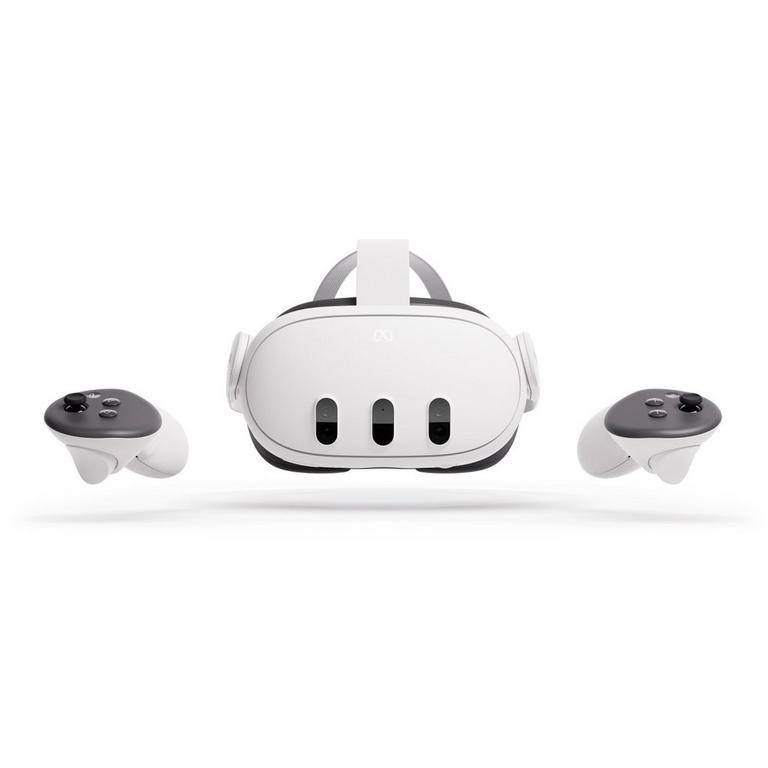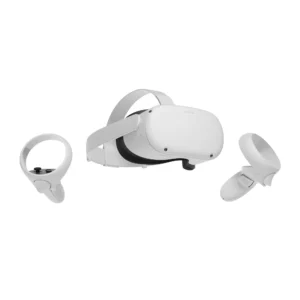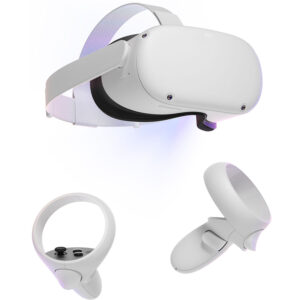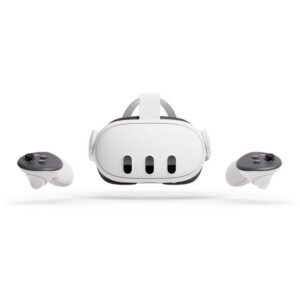The Meta Quest 3 is a VR headset, but its guts are closer to a phone than any other gadget. Having reviewed the Quest and spent countless hours with just about every other VR headset out there I was curious to see how latest Meta device performs. My love for all things VR dates back to the original HMD (Vive DK1), followed by various experiments with Samsung’s Gear VR, Google’s Cardboard and Daydream platforms, and View headsets. I liked the original Oculus Rift, PlayStation VR, and Pimax 4K but arguably spent the most time with Lenovo Explorer Windows Mixed Reality, before moving to the Quest 2 back in 2020.
Finally, we should talk briefly about haptics and vibration. The new Touch Plus controllers have what Meta is calling TruTouch Haptics. There is little official info as to exactly what has changed in terms of hardware, but you can tell the difference between the Quest 2 and Quest 3 vibrations. The Quest 3 seems to have a wider range of vibrations with more subtle and gradually variable patterns.
Displays and visual fidelity
The Quest line has been on a steady increase in terms of display resolution. The original Quest had a 1440×1600 pixel resolution per eye, which the Quest 2 bumped up to 1832×1920 pixels. Now, the Quest 3 has 2064×2208 pixels per eye. This is a Peak Pixel Density increase from around 20 PPD in the Quest 2 to around 25 PPD in the Quest 3. And it makes a tangible difference as the Quest 3 fares noticeably better than its predecessor with fine detail and making text much more legible. Meta has leveraged that fact straight from the get-go by implementing smaller fonts throughout the Quest 3 UI.
Speaking of resolution, we should address the topic of Screen Door Effect (SDE). If you have been interested in VR and have been reading up on the subject or have tried an older headset some time ago, there’s a good chance SDE was a major turnoff. SDE is the visual artifact arising from insufficient display resolution in some, mostly older headsets where you could actually make out the individual pixels of the display and most annoyingly – the space between said pixels since the display is so physically close to the eyes. We can confidently say that we hardly notice any Screen Door Effect on the Quest 2, and with its higher resolution still, the Quest 3 is practically free of it entirely.
On the downside the Quest 3, just like the Quest 2, uses LCD tech instead of OLED. And while the older tech is no match for the deep blacks and punchy colors of OLED we can’t say we found the Quest 3 lacking on either account. We also didn’t see issues with pixel-response time, which can be a pain point of some LCDs. Honestly, we couldn’t tell the difference even if it was the best type of “controlled” test we managed to set up. In its current state, VR displays still have much more basic things to worry about, like proper focus and fogging, making higher-end display discussions like motion smearing a bit less relevant.
The Quest 3 actually uses two LCD RGB displays – a change from the Quest 2, which uses a singular LCD panel segmented into two parts for each eye. Just like the Quest 2, the Quest 3 can refresh at up to 120Hz. However, we suspect that there might still be some advantages in the refresh rate with the Quest 3 since the high refresh rate figure on the Quest 2 was achieved through updates and overclocking after the launch. In any case, we can’t say that the picture is any blurrier in motion on the Quest 2 compared to the Quest 3, at least to our eyes. The Quest 3 can be configured to refresh at 72Hz, 90Hz or 120Hz with the lower values sacrificing some of the visual smoothness for a bit of extra battery life. It makes sense for things like watching videos.
Where we did see a major difference and an upgrade from the Quest 2 to the Quest 3 is the lenses. The Quest 2 has some pretty impressive Fresnel lenses. Some of the best in the business, in fact, but the Quest 3 has what are known as Pancake lenses.
We won’t bore you with too much details, but the thing to note is that these Pancake lenses are much flatter and more uniform. Looking through them causes far less distortion. The really noticeable bit is the improved sharpness and clarity near the edges of the lenses. It is much better on the Quest 3 than the Quest 2, which can get blurry near the edges of the lens and requires a much more precise placement in front of your eyes.
We already mentioned this, but it is worth reiterating that the Quest 3 has a noticeably wider field of view compared to the Quest 2. The Quest 3 has an officially advertised FoV of around 110 degrees horizontally and 96 degrees vertically. That is compared to 97-degree horizontal and 93-degree vertical on the Quest 2. The difference is noticeable, if you’ve spent enough time with both headsets. However, even after the FoV update, the Quest 3 still has a bit of a “tunnel vision” effect to it, but you get used to it quicker and stop noticing it.
Of course, the horizontal FoV will inevitably vary a bit based on your IPD settings. The wider IPD range of 58-71mm (compared to 58-68 on the Quest 2) can be a big game-changer for some people. Also, there is the universal upgrade of adjusting the IPD on a continuous slider while wearing the headset so you can dial in the right value.
Finally, rounding off the display section, we should mention that the Quest 3 advertises a display brightness of 100 nits. It sounds quite low compared to a phone’s panel, but remember that we are talking about displays that are extremely close to your eyes. We never found ourselves wanting more brightness. The Quest 3 has a well-optimized face plate shape that fits very snuggly on this reviewer’s face, resulting in almost no external light bleed.
Internals and performance
Internals are another area of major generational improvement for the Quest line. The original Oculus Quest kind of predated Qualcomm’s push into the realm of VR-specific hardware and employed the commodity Snapdragon 835 chipset with 4GB of RAM. The Quest 2 was then upgraded to the Qualcomm Snapdragon XR2 Gen 1 with 6GB of RAM.
The Quest 3 continues this tradition of performance uplifts and is based around the Qualcomm Snapdragon XR2 Gen 2. It is a 4nm chip compared to the 7nm design of the Gen 1 chip inside the Quest 2, so it should be far more efficient.
Qualcomm claims that the Quest 3 lasts between two to three hours on a single charge, depending on what you are doing, just like the Quest 2. Since the battery capacity has increased, we can only assume that the improved efficiency of the Snapdragon XR Gen 2 was traded for extra perfomance. In fact our testing showed marginally shoter battery life on the Quest 3 compared to the Quest 2.
The Snapdragon XR2 Gen 2 has a CPU configuration with eight total cores – 1 x 3.19 GHz, 4 x 2.8 GHz, 3 x 2.0 GHz. This promises a nice CPU performance bump over the last gen and the Quest 2. On the GPU side of things, we have an Adreno 740, which, depending on whether you ask Oculus or Qualcomm, is between two and 2.5 times more performant than the Adreno 650 inside the Quest 2.
The Snapdragon XR2 Gen 2 also promises an up to 8 times AI performance boost depending on the task at hand. This is leveraged for on-device processing of things like head, controller and hand tracking, depth estimation and 3D reconstruction. The chipset also has an upgraded ISP with support for up to 10 concurrent cameras and full-color, ultra-fast see-through/pass-through with a latency as small as 12ms. Indeed, the pass-through latency on the new full-color pass-through mode of the Quest 3 is impressively low, and the feed is near real-time.
There are no reliable, repeatable, well-determined test scenarios and benchmarks to run on VR headsets. Still, since the Quest 3, like the Quest 2, technically runs a modified version of Android (Android 12 in both cases as of writing this review), we couldn’t skip on the opportunity to run some traditional Android benchmarks on both headsets for some rough performance estimates. We should note that all of these benchmarking apps ran in rather odd window “containers” within the Quest UI, oftentimes with visual, navigational and other UI glitches, so take the results with a grain of salt.
Let’s kick things off with GeekBench and its CPU tests. We can see that the Quest 3 and the Snapdragon XR2 Gen 2 definitely have a lead over the Quest 2 and the Snapdragon XR2 Gen 1, but it’s not what we would call huge advantage.
Meta Oculus Quest 3 specifications
| Headset | Meta Quest 3 |
| SoC | Qualcomm Snapdragon XR2 Gen 2 |
| RAM | 8GB |
| Storage | 128GB/512GB |
| Resolution (Per-eye) | 2064 × 2208 |
| Display type | LCD |
| Refresh rate | 120Hz |
| Field of view | 110-degrees horizontal/92-degrees vertical |
| Lenses | Pancake |
| Features | Hand tracking, PC compatibility, voice commands, wireless, Mixed reality |
| Controllers | Touch Plus controllers |
| Weight | 513g |
| Price | $499/$649 |
The Meta Quest 3 is powered by the cutting-edge Qualcomm Snapdragon XR2 Gen 2. Meta claims that the Quest 3 delivers twice the graphics processing power of its predecessor, the Quest 2. Additionally, the Quest 3 also receives a memory upgrade, featuring 8GB of RAM compared to the Quest 2’s 6GB. It’s worth noting that the Quest 3 falls short of the Meta Quest Pro’s 12GB RAM offering.
The Quest 3 offers a slight improvement in display specifications. The headset has a 120Hz refresh rate, providing smoother visuals right out of the box. While the Quest 2 has an experimental 120Hz mode, integrating it into the Quest 3 is a welcome addition.
Meta has also upgraded the display of the Quest 3. Referred to as the 4K+ Infinite Display, the Quest 3 utilizes two LCDs with pancake optics to achieve a resolution of 2,064 x 2,208 pixels per eye. Meta claims this enhancement results in nearly 30% higher resolution than the Quest 2. The Quest 3 boasts a resolution of 25 pixels per degree (PPD) in virtual reality and 1,218 pixels per inch (PPI).
When utilizing the full-color video passthrough feature, the resolution does experience a slight decrease. In mixed reality, the resolution stands at 18 PPD, powered by two RGB cameras, as opposed to the 25 PPD resolution in virtual reality. Nevertheless, this is still an upgrade, as Meta states that the passthrough mode offers “over 10x more pixels compared to Quest 2 and 3x more pixels compared to Quest Pro.”
In terms of refresh rate, the Quest 3 offers a native 90Hz refresh rate with an experimental 120Hz option. While there is hope that future updates may enable a 144Hz refresh rate, the maximum available is 120Hz.
One area in which the Quest 3 does not receive an upgrade is battery life. It maintains the same battery life as the Quest 2, with Meta stating that it typically lasts around 2.2 hours but can reach 2.9 hours when used solely for media consumption. The headset can be fully charged from 0% in two hours using the included 18W charger, which is consistent with the charging capabilities of the Quest 2.









Reviews
There are no reviews yet.